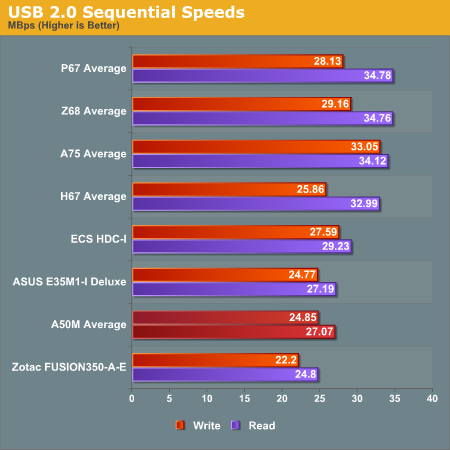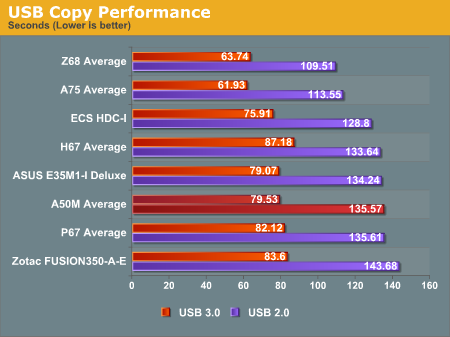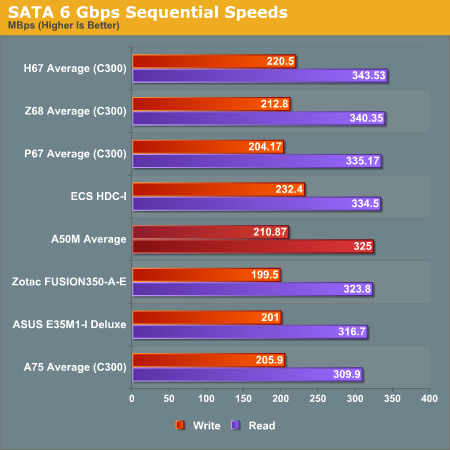Fusion E-350 Review: ASUS E35M1-I Deluxe, ECS HDC-I and Zotac FUSION350-A-E
by Ian Cutress on July 14, 2011 11:00 AM ESTLAN Speed Test
LAN Speed Test is a freeware program designed for testing the network connection between two PCs on a home network. The speed of the transfer is limited by the lowest common denominator on the network, so if you have gigabit Ethernet capable computers but a 100 Mbit capable router, you are limited to 100 Mbit transfer. Note that this is really a formality – if a network port is rated at 1 Gbps, then chances are that it will hit at least 90+% of this value. The main test here is CPU usage, and how much is offloaded by the controller. For this test, we use LAN Speed Test to transfer a 1000 MB file across a home network with a 100 Mbps lowest common speed to the same machine each time, in a read/write scenario. CPU usage is taken as a visual max/average from task manager.

The Fusion boards don't have anything out of the ordinary in the LAN Speed test.

Due to the E-350 CPU in the Fusion boards, transferring data across the network is actually a CPU intensive task, with most boards having a substantial CPU usage. The Zotac has the lowest average CPU usage, but the ASUS has the lowest peak. The ECS board performs badly here, though.
USB Speed
For this benchmark, we run CrystalDiskMark to determine the ideal sequential read and write speeds for the USB port using our 64GB Patriot SuperSpeed USB 3.0 drive. Then we transfer a set size of files from the SSD to the USB drive, and monitor the time taken to transfer. The files transferred are a 1.52 GB set of 2867 files across 320 folders – 95% of these files are small typical website files, and the rest (90% of the size) are HD videos.



Across the USB tests, the Zotac underperforms by quite a considerable margin. I redid the tests, and then got in touch with Zotac regarding this issue. I was given a new BIOS, but this did not improve the results. The ECS board has the best USB performance out of the three A50M boards.
SATA Testing
We also use CrystalDiskMark for SATA port testing. The operating system is installed on the Micron RealSSD C300, which is rated at 355 MB/s read and 215 MB/s write, and the sequential test is run at the 5 x 1000 MB level. This test probes the efficiency of the data delivery system between the chipset and the drive, or in the case of additional SATA ports provided by a third party controller, the efficiency between the controller, the chipset and the drive.

Using the Micron C300, the ECS board outperforms the other two in sequential writes and reads.
DPC Latency
Deferred Procedure Call latency is a way in which Windows handles interrupt servicing. In order to wait for a processor to acknowledge the request, the system will queue all interrupt requests by priority. Critical interrupts will be handled as soon as possible, whereas lesser priority requests, such as audio, will be further down the line. So if the audio device requires data, it will have to wait until the request is processed before the buffer is filled. If the device drivers of higher priority components in a system are poorly implemented, this can cause delays in request scheduling and process time, resulting in an empty audio buffer – this leads to characteristic audible pauses, pops and clicks. Having a bigger buffer and correctly implemented system drivers obviously helps in this regard. The DPC latency checker measures how much time is processing DPCs from driver invocation – the lower the value will result in better audio transfer at smaller buffer sizes. Results are measured in microseconds and taken as the peak latency while cycling through a series of short HD videos - under 500 microseconds usually gets the green light, but the lower the better.

Due to the E-350 CPU, the DPC Latency results of these boards seem a lot worse than the Cougar Point boards we've tested this year. In reality, not many of us will notice this difference.
*A small note about the Zotac board - every thirty seconds or so, a DPC spike is observed around 6000 microseconds. This could seriously be an issue if audio is important to the users of this board - after retesting the board and contacting Zotac, they have not pinpointed the issue yet, but as I understand it, are working on a fix.










67 Comments
View All Comments
andymcca - Friday, July 15, 2011 - link
My bad, missed this on page 11 during my first read-through.tvarad - Friday, July 15, 2011 - link
Ian,I understand your compulsions, but it's like taking a Smart, testing it like a Ferrari and then critiquing it. That's not quite what AMD had in mind on how it intended the board to be used (I own Intel stock, so this is not about taking sides). I have the Asus board and I am using it with a tiny brick that puts out about 47W and powers a Pico-psu 120W 12V-25V wide input range power supply. It's function is as a HTPC/Video Server, hence I have just a 2TB WD HD attached to it, with an external removable media drive. With 2GB Gskill Eco Ram and a 140MM fan, it never goes above 40W when booting up and idles at around 22-23W. With 1080P mkv content play, the consumption goes upto about 30W. I don't plan to overclock it. I'll go out on a limb and say that my rig is more representative of how the board will be used in the real world.
BTW, the square thingies on the pico-psu (at least the model I'm using) jut out onto the second dimm slot rendering it useless. Something you may want to watch out for.
triclops41 - Thursday, July 14, 2011 - link
Easy there, Finally,There are things to criticize about this review on benchmarks chosen or other technical details, but I have not seen any pro atom or anti brazos bias by Ian, or anyone else at Anandtech. Maybe some bias towards synthetic benchmarks, that Intel often wins, but that has more to do with the constraints of hardware reviews, not allegiance to some producer.
Finally - Tuesday, July 26, 2011 - link
Well said. I still really wonder, why there are so many encoding benchmarks here. After all - how many people actually do encode videos? I've never done so my whole life and don't intend starting to. The funny thing is that these are usually the benchmarks where the press is deriving their ridiculous high speed advantages of new Intel CPUs from...If someone came along and said that this "advantage" is completely lost on them, those CPUs wouldn't be that great, because real world game fps are almost always very close to each other...
corporategoon - Thursday, July 14, 2011 - link
I don't really have any comments on the benchmarks or thoroughness or balance of this article (seems fine to me) but this is one of the most poorly-written articles I've ever seen on AnandTech. Anand has a serious problem with sentence fragments but most articles that appear on the site are reasonably well-written. The opening paragraph is borderline unreadable.new-paradigm - Thursday, July 14, 2011 - link
Ok, I may be being dense, but I cant seem to find if any of these boards offer video and sound through the HDMI port?jrs77 - Thursday, July 14, 2011 - link
I've got two miniITX Atom boards. A Zotac IONITX A-E and an ASUS AT3IONT-I Deluxe (both sporting an onboard PSU with a 90Watt powerbrick !!!). Both of them do work like a charm and I'm even capable of playing MMOs (EvE Online) on them in low settings. They draw some 35 Watt from the plug in the wall under load.So why there's no comparison to the Atom-ION boards as they're the direct competition and on the market for a few years now allready?
stmok - Friday, July 15, 2011 - link
While the overall article is OK, it just doesn't have that usefulness of your typical Anandtech article in some areas that make it stand out.For example:
Why did you not include the ECS solution alongside the ASUS one for the overclock part on page 15?
=> http://www.anandtech.com/show/4499/fusion-e350-rev...
What about assessing noise?
=> Sure, you have the two passive mobos, but how loud/quiet was that fan cooled one?
futurepastnow - Friday, July 15, 2011 - link
Looks like the big heatsink ASUS uses is mostly for show since the much smaller one on the Zotac board puts it to shame.beginner99 - Friday, July 15, 2011 - link
... of bobcat. In the forums you can read it having trouble with 1080p sometimes especially flash. Not ideal for a htpc. The GPU part is mostly useless for a HTPC or NAS. Also these mini-ITX boards are pretty expensive and mini-ITX + core i3 doesn't cost much more and would also not use much more power in idle/normal usage but better max. performance for like flash (HTPC) or Software RAID 5 (NAS).Especially for a NAS the price difference is minimal because any small case with lots of HDD bays is pretty expensive.